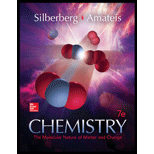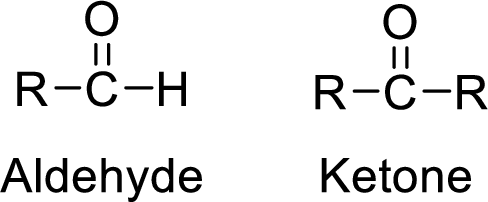
Student Study Guide for Silberberg Chemistry: The Molecular Nature of Matter and Change
7th Edition
ISBN: 9780078131615
Author: Martin Silberberg Dr.
Publisher: McGraw-Hill Education
expand_more
expand_more
format_list_bulleted
Question
Chapter 15, Problem 15.62P
Interpretation Introduction
Interpretation:
The
Concept Introduction:
Aldehydes and ketones are carbonyl compounds. In carbonyl compounds, carbon is bonded to oxygen with a double bond. In aldehydes, carbon bonded to oxygen is bonded to one hydrogen and one carbon. In ketone, carbon bonded to oxygen is bonded to two carbon atoms.

Expert Solution & Answer
Want to see the full answer?
Check out a sample textbook solution
Students have asked these similar questions
A block of copper of mass
2.00kg(cp
= 0.3851
.K) and
g
temperature 0°C is introduced into
an insulated container in which there
is 1.00molH, O(g) at 100°C and 1.00
2
atm. Note that
C
P
= 4.184. K for liquid water, and
g
that A
H = 2260 for water.
vap
g
Assuming all the steam is condensed
to water, and that the pressure
remains constant:
(a) What will be the final temperature
of the system?
(b) What is the heat transferred from
the water to the copper?
(c) What is the entropy change of the
water, the copper, and the total
system?
Identify the missing organic reactants in the following reaction:
H+
X + Y
OH
H+
O
O
Note: This chemical equation only focuses on the important organic molecules in the reaction. Additional inorganic or small-molecule
reactants or products (like H₂O) are not shown.
In the drawing area below, draw the skeletal ("line") structures of the missing organic reactants X and Y. You may draw the
structures in any arrangement that you like, so long as they aren't touching.
Explanation
Check
Click and drag to start drawing a
structure.
X
G
2025 McGraw Hill LLC. All Rights Reserved. Terms of Use | Privacy Cente
?
E
Calculate the solubility of CaF2 in g/L (Kp = 4.0 x 10-8).
sp
Chapter 15 Solutions
Student Study Guide for Silberberg Chemistry: The Molecular Nature of Matter and Change
Ch. 15.2 - Prob. 15.1AFPCh. 15.2 - Prob. 15.1BFPCh. 15.2 - Prob. 15.2AFPCh. 15.2 - Prob. 15.2BFPCh. 15.2 - How many peaks appear in the NMR spectrum of each...Ch. 15.2 - Prob. B15.2PCh. 15.2 - Prob. B15.3PCh. 15.3 - Prob. 15.3AFPCh. 15.3 - Prob. 15.3BFPCh. 15.4 - Prob. 15.4AFP
Ch. 15.4 - Prob. 15.4BFPCh. 15.4 - Prob. 15.5AFPCh. 15.4 - Prob. 15.5BFPCh. 15.4 - Prob. 15.6AFPCh. 15.4 - Prob. 15.6BFPCh. 15.4 - Prob. 15.7AFPCh. 15.4 - Prob. 15.7BFPCh. 15.6 - Prob. B15.4PCh. 15.6 - Prob. B15.5PCh. 15 - Prob. 15.1PCh. 15 - Prob. 15.2PCh. 15 - Prob. 15.3PCh. 15 - Silicon lies just below carbon in Group 4A(14) and...Ch. 15 - What is the range of oxidation states for carbon?...Ch. 15 - Prob. 15.6PCh. 15 - Prob. 15.7PCh. 15 - Define each type of isomer: (a) constitutional;...Ch. 15 - Prob. 15.9PCh. 15 - Prob. 15.10PCh. 15 - Prob. 15.11PCh. 15 - How does an aromatic hydrocarbon differ from a...Ch. 15 - Prob. 15.13PCh. 15 - Prob. 15.14PCh. 15 - Prob. 15.15PCh. 15 - Prob. 15.16PCh. 15 - Prob. 15.17PCh. 15 - Prob. 15.18PCh. 15 - Prob. 15.19PCh. 15 - Prob. 15.20PCh. 15 - Prob. 15.21PCh. 15 - Prob. 15.22PCh. 15 - Prob. 15.23PCh. 15 - Prob. 15.24PCh. 15 - Draw structures from the following names, and...Ch. 15 - Prob. 15.26PCh. 15 - Prob. 15.27PCh. 15 - Prob. 15.28PCh. 15 - Prob. 15.29PCh. 15 - Prob. 15.30PCh. 15 - Prob. 15.31PCh. 15 - Prob. 15.32PCh. 15 - Prob. 15.33PCh. 15 - Prob. 15.34PCh. 15 - Prob. 15.35PCh. 15 - Prob. 15.36PCh. 15 - Prob. 15.37PCh. 15 - Prob. 15.38PCh. 15 - Prob. 15.39PCh. 15 - Prob. 15.40PCh. 15 - Determine the type of each of the following...Ch. 15 - Prob. 15.42PCh. 15 - Prob. 15.43PCh. 15 - Prob. 15.44PCh. 15 - Prob. 15.45PCh. 15 - Prob. 15.46PCh. 15 - Prob. 15.47PCh. 15 - Prob. 15.48PCh. 15 - Prob. 15.49PCh. 15 - Prob. 15.50PCh. 15 - Prob. 15.51PCh. 15 - Prob. 15.52PCh. 15 - Prob. 15.53PCh. 15 - Prob. 15.54PCh. 15 - Prob. 15.55PCh. 15 - Prob. 15.56PCh. 15 - Prob. 15.57PCh. 15 - Prob. 15.58PCh. 15 - Prob. 15.59PCh. 15 - Prob. 15.60PCh. 15 - Prob. 15.61PCh. 15 - Prob. 15.62PCh. 15 - Prob. 15.63PCh. 15 - Prob. 15.64PCh. 15 - Prob. 15.65PCh. 15 - Prob. 15.66PCh. 15 - Prob. 15.67PCh. 15 - Prob. 15.68PCh. 15 - Prob. 15.69PCh. 15 - Prob. 15.70PCh. 15 - Prob. 15.71PCh. 15 - Prob. 15.72PCh. 15 - Prob. 15.73PCh. 15 - Prob. 15.74PCh. 15 - Prob. 15.75PCh. 15 - Prob. 15.76PCh. 15 - Prob. 15.77PCh. 15 - Prob. 15.78PCh. 15 - Prob. 15.79PCh. 15 - Prob. 15.80PCh. 15 - Prob. 15.81PCh. 15 - Prob. 15.82PCh. 15 - Prob. 15.83PCh. 15 - Prob. 15.84PCh. 15 - Prob. 15.85PCh. 15 - Prob. 15.86PCh. 15 - Prob. 15.87PCh. 15 - What is the key structural difference between...Ch. 15 - Protein shape, function, and amino acid sequence...Ch. 15 - What linkage joins the monomers in each strand of...Ch. 15 - What is base pairing? How does it pertain to DNA...Ch. 15 - RNA base sequence, protein amino acid sequence,...Ch. 15 - Prob. 15.93PCh. 15 - Prob. 15.94PCh. 15 - Draw the structure of each of the following...Ch. 15 - Prob. 15.96PCh. 15 - Write the sequence of the complementary DNA strand...Ch. 15 - Prob. 15.98PCh. 15 - Prob. 15.99PCh. 15 - Prob. 15.100PCh. 15 - Prob. 15.101PCh. 15 - Amino acids have an average molar mass of 100...Ch. 15 - Prob. 15.103PCh. 15 - Prob. 15.104PCh. 15 - Some of the most useful compounds for organic...Ch. 15 - Prob. 15.106PCh. 15 - Prob. 15.107PCh. 15 - Prob. 15.108PCh. 15 - Prob. 15.109PCh. 15 - Prob. 15.110PCh. 15 - Prob. 15.111PCh. 15 - Prob. 15.112PCh. 15 - The polypeptide chain in proteins does not exhibit...Ch. 15 - Prob. 15.114PCh. 15 - Prob. 15.115PCh. 15 - Prob. 15.116PCh. 15 - Prob. 15.117PCh. 15 - Wastewater from a cheese factory has the following...Ch. 15 - Prob. 15.119P
Knowledge Booster
Similar questions
- For the following reaction with excess reagent, predict the product. Be sure your answer accounts for stereochemistry. If multiple stereocenters are formed, be sure to draw all products using appropriate wedges and dashes. 1. EtLi, Et₂O CH₁ ? 2. H₂O*arrow_forwardWrite the systematic name of each organic molecule: structure 요 OH ہو۔ HO OH name X S ☐ ☐arrow_forwardPredict the major products of this organic reaction. If there aren't any products, because nothing will happen, check the box under the drawing area instead. D ㄖˋ ید H No reaction. + 5 H₂O.* Click and drag to start drawing a structure. OH H₂Oarrow_forward
- Draw one product of an elimination reaction between the molecules below. Note: There may be several correct answers. You only need to draw one of them. You do not need to draw any of the side products of the reaction 'O 10 + x 也 HO + 义 Click and drag to start drawing a structure.arrow_forwardWhat are the angles a and b in the actual molecule of which this is a Lewis structure? H- :0: C=N: b Note for advanced students: give the ideal angles, and don't worry about small differences from the ideal that might be caused by the fact that different electron groups may have slightly different sizes. a = 0° b=0 Xarrow_forwardA student proposes the transformation below in one step of an organic synthesis. There may be one or more products missing from the right-hand side, but there are no reagents missing from the left-hand side. There may also be catalysts, small inorganic reagents, and other important reaction conditions missing from the arrow. • Is the student's transformation possible? If not, check the box under the drawing area. • If the student's transformation is possible, then complete the reaction by adding any missing products to the right-hand side, and adding required catalysts, inorganic reagents, or other important reaction conditions above and below the arrow. • You do not need to balance the reaction, but be sure every important organic reactant or product is shown. + This transformation can't be done in one step. T iarrow_forward
- Determine the structures of the missing organic molecules in the following reaction: H+ O OH H+ + H₂O ☑ ☑ Note: Molecules that share the same letter have the exact same structure. In the drawing area below, draw the skeletal ("line") structure of the missing organic molecule X. Molecule X shows up in multiple steps, but you only have to draw its structure once. Click and drag to start drawing a structure. X § ©arrow_forwardTable 1.1 Stock Standard Solutions Preparation. The amounts shown should be dissolved in 100 mL. Millipore water. Calculate the corresponding anion concentrations based on the actual weights of the reagents. Anion Amount of reagent (g) Anion Concentration (mg/L) 0.1649 Reagent Chloride NaCl Fluoride NaF 0.2210 Bromide NaBr 0.1288 Nitrate NaNO3 0.1371 Nitrite NaNO2 0.1500 Phosphate KH2PO4 0.1433 Sulfate K2SO4 0.1814arrow_forwardDraw the structure of the pound in the provided CO as a 300-1200 37(2), 11 ( 110, and 2.5 (20arrow_forward
- Please help me with # 4 and 5. Thanks in advance!arrow_forwardA small artisanal cheesemaker is testing the acidity of their milk before it coagulates. During fermentation, bacteria produce lactic acid (K₁ = 1.4 x 104), a weak acid that helps to curdle the milk and develop flavor. The cheesemaker has measured that the developing mixture contains lactic acid at an initial concentration of 0.025 M. Your task is to calculate the pH of this mixture and determine whether it meets the required acidity for proper cheese development. To achieve the best flavor, texture and reduce/control microbial growth, the pH range needs to be between pH 4.6 and 5.0. Assumptions: Lactic acid is a monoprotic acid H H :0:0: H-C-C H :0: O-H Figure 1: Lewis Structure for Lactic Acid For simplicity, you can use the generic formula HA to represent the acid You can assume lactic acid dissociation is in water as milk is mostly water. Temperature is 25°C 1. Write the K, expression for the dissociation of lactic acid in the space provided. Do not forget to include state symbols.…arrow_forwardCurved arrows are used to illustrate the flow of electrons. Using the provided starting and product structures, draw the curved electron-pushing arrows for the following reaction or mechanistic step(s). Be sure to account for all bond-breaking and bond-making steps. :0: :0 H. 0:0 :0: :6: S: :0: Select to Edit Arrows ::0 Select to Edit Arrows H :0: H :CI: Rotation Select to Edit Arrows H. < :0: :0: :0: S:arrow_forward
arrow_back_ios
SEE MORE QUESTIONS
arrow_forward_ios
Recommended textbooks for you
 ChemistryChemistryISBN:9781305957404Author:Steven S. Zumdahl, Susan A. Zumdahl, Donald J. DeCostePublisher:Cengage Learning
ChemistryChemistryISBN:9781305957404Author:Steven S. Zumdahl, Susan A. Zumdahl, Donald J. DeCostePublisher:Cengage Learning ChemistryChemistryISBN:9781259911156Author:Raymond Chang Dr., Jason Overby ProfessorPublisher:McGraw-Hill Education
ChemistryChemistryISBN:9781259911156Author:Raymond Chang Dr., Jason Overby ProfessorPublisher:McGraw-Hill Education Principles of Instrumental AnalysisChemistryISBN:9781305577213Author:Douglas A. Skoog, F. James Holler, Stanley R. CrouchPublisher:Cengage Learning
Principles of Instrumental AnalysisChemistryISBN:9781305577213Author:Douglas A. Skoog, F. James Holler, Stanley R. CrouchPublisher:Cengage Learning Organic ChemistryChemistryISBN:9780078021558Author:Janice Gorzynski Smith Dr.Publisher:McGraw-Hill Education
Organic ChemistryChemistryISBN:9780078021558Author:Janice Gorzynski Smith Dr.Publisher:McGraw-Hill Education Chemistry: Principles and ReactionsChemistryISBN:9781305079373Author:William L. Masterton, Cecile N. HurleyPublisher:Cengage Learning
Chemistry: Principles and ReactionsChemistryISBN:9781305079373Author:William L. Masterton, Cecile N. HurleyPublisher:Cengage Learning Elementary Principles of Chemical Processes, Bind...ChemistryISBN:9781118431221Author:Richard M. Felder, Ronald W. Rousseau, Lisa G. BullardPublisher:WILEY
Elementary Principles of Chemical Processes, Bind...ChemistryISBN:9781118431221Author:Richard M. Felder, Ronald W. Rousseau, Lisa G. BullardPublisher:WILEY

Chemistry
Chemistry
ISBN:9781305957404
Author:Steven S. Zumdahl, Susan A. Zumdahl, Donald J. DeCoste
Publisher:Cengage Learning

Chemistry
Chemistry
ISBN:9781259911156
Author:Raymond Chang Dr., Jason Overby Professor
Publisher:McGraw-Hill Education

Principles of Instrumental Analysis
Chemistry
ISBN:9781305577213
Author:Douglas A. Skoog, F. James Holler, Stanley R. Crouch
Publisher:Cengage Learning

Organic Chemistry
Chemistry
ISBN:9780078021558
Author:Janice Gorzynski Smith Dr.
Publisher:McGraw-Hill Education

Chemistry: Principles and Reactions
Chemistry
ISBN:9781305079373
Author:William L. Masterton, Cecile N. Hurley
Publisher:Cengage Learning

Elementary Principles of Chemical Processes, Bind...
Chemistry
ISBN:9781118431221
Author:Richard M. Felder, Ronald W. Rousseau, Lisa G. Bullard
Publisher:WILEY